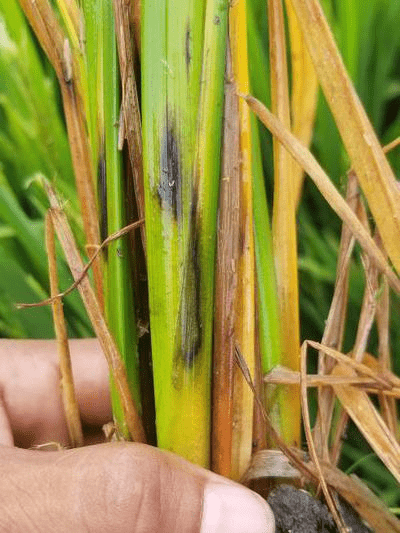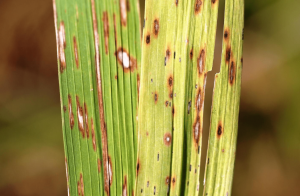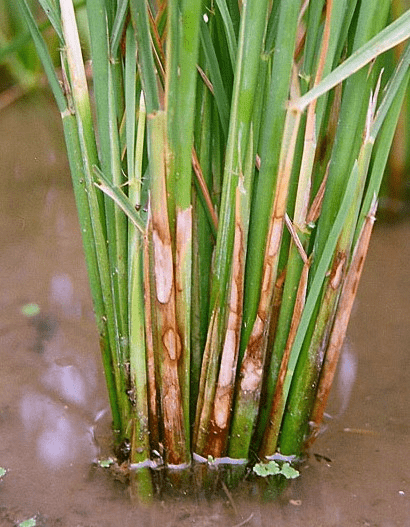Paddy diseases can have a devastating impact on rice production and farmers’ livelihoods. It is one of the most important food crops in India which covers 1/4th of the total cropped area. Rice is the staple food for more than half of the world’s population. India stands in the second position after China in global rice production. Total rice production in the year 2022-23 is 125 million tonnes. The total area under rice cultivation in 2022-23 is 45.5 million hectares with an average productivity of about 4.1 tonnes/ha. In India, Paddy is grown mostly during the Kharif season. It grows well in tropical and sub-tropical hot and humid climates.
It is crucial to understand the causes, symptoms, and treatment options for paddy diseases to prevent their spread and minimize their impact. In this listicle, we will explore 11 common paddy diseases and what you need to know about them.
The scientific name of paddy: Oryza sativa
11 Major Paddy Diseases:
1. Rice Blast or Blast of Rice:
Causal agent: Pyricularia oryzae (Sexual stage: Magnaporthe grisea)
Affecting stages: All crop stages from seedling to late tillering and ear heading stage
It is one of the most destructive Paddy diseases. The disease affects all parts of rice plants, mainly leaves, neck and nodes. It is expected to cause grain loss by 70 – 80%.
Rice Blast Symptoms:
- Leaf Blast Of Rice – Spindle-shaped spots with grey centre and brown margin, later causing a ‘Blasted’ or ‘Burnt’ appearance
- Neck Blast Of Rice – Greyish brown lesions on the neck, panicle breaks and fall off
- Node Blast Of Rice – Affected nodes show black lesions which later break up
Favourable Conditions For Blast of Rice Disease:
Areas having prolonged or frequent rainfall, lower soil moisture, cooler temperature and high relative humidity of about 93-99% are more susceptible to this disease.
Buy Fungicide for Rice Blast:
| Product Name | Technical content |
| Contaf Fungicide | Hexaconazole 5 % EC |
| Nativo Fungicide | Tebuconazole 50% + Trifloxystrobin 25% WG |
| Dhanuka Kasu-B Fungicide | Kasugamacyin 3% SL |
| Folicur Fungicide | Tebuconazole 250 EC |
2. Bacterial Leaf Blight Of Rice:
Causal agent: Xanthomonas oryzae
Affecting stages: Tillering stage to Heading stage
Bacterial Leaf Blight Of Rice Symptoms:
- Water-soaked spots appear on leaves which gradually coalesce to form blotches and white streaks form from the tip of the leaf to the base.
- Wilting and yellowing of leaves
- Usually known as ‘Seedling wilt’ or ‘Kresek’
Favourable Conditions For Bacterial Leaf Blight Of Rice:
Occurs mostly in irrigated and rainfed lowlands. The temperature of 25 – 34°C, Relative Humidity above 70%, high nitrogen fertilization, strong winds and continuous rainfall are favourable conditions for disease infection.
Buy Chemical Management For Bacterial Leaf Blight Of Rice:
| Product Name | Technical content |
| Blue Copper | Copper Oxychloride 50% WP |
| Cristocycline | Streptomycin sulphate 90% + Tetracylin hydrochloride 10% SP |
| Geolife Geomycin | Consortium of Plant Extracts |
| Conika | Kasugamycin 5% + Copper Oxychloride 45% WP |
Discover the ultimate defence against bacterial leaf disease in paddy. Click here for a detailed view!
3. Sheath Rot Of Rice:

Causal agent: Sarocladium oryzae
Affecting Stages: Boot leaf stage
Sheath Rot Of Rice Symptoms:
- Irregular greyish-brown water-soaked lesions on flag leaf sheath
- White powdery fungal growth inside the affected sheath
Favourable Conditions For Sheath Rot Of Rice:
It is most prevalent during wet seasons compared to dry seasons. High nitrogen fertilization, plants with injuries and wounds, high relative humidity and temperature of 20 – 28°C, and closer planting density are some favourable conditions for disease incidence.
Buy Chemical Management For Sheath Rot of Rice:
| Product Name | Technical content |
| Dhanustin Fungicide | Carbendazim 50% WP |
| Kavach Fungicide | Chlorothalonil 75% WP |
| Tata Master Fungicide | Metalaxyl 8% + Mancozeb 64% WP |
| Conika Fungicide | Kasugamycin 5% + Copper Oxychloride 45% WP |
Want to safeguard your paddy crops? Get an in-depth understanding of Sheath Rot disease. Click here
4. Brown Spot Of Rice:

Causal agent: Helminthosporium oryzae
Affecting Stages: Seedling to milky stage
Brown Spot Of Rice Symptoms:
- Oval or cylindrical dark brown spots with a yellow halo
- Infection of florets can lead to incomplete grain filling and reduced grain quality
Favourable Conditions for Rice Brown Spot:
Relative Humidity above 86 – 100%, a temperature of 16 – 36°C, and infected seeds, weeds, and infected stubbles are some conditions favourable for disease infection.
Buy Chemical Management for Rice Brown Spot:
| Product Name | Technical content |
| Tilt Fungicide | Propiconazole 25%EC |
| Contaf Plus Fungicide | Hexaconazole 5 % SC |
| Merger Fungicide | Tricyclazole 18 % + Mancozeb 62 % WP |
| Godiwa Super Fungicide | Azoxystrobin 18.2% + Difenoconazole 11.4% SC |
Shield your harvest from Brown Spot disease in paddy! Click here to discover vital insights for crop protection.
5. False Smut Of Rice
Causal agent: Ustilaginoidea virens
Affecting stages: Flowering stage to maturity
False Smut Of Rice Symptoms:
- Spikelets have orange or greenish-black velvety smut balls
- This leads to chaffy grains
Favourable Conditions For False Smut Of Rice:
A temperature of 25 – 35°C, Relative Humidity above 90%, high nitrogen fertilization, heavy rainfall and winds are favourable conditions for false smut infection.
Buy Chemical Management for False Smut Of Rice:
| Product Name | Technical content |
| Amistar top fungicide | Azoxystrobin 18.2% + Difenoconazole 11.4% SC |
| Roko Fungicide | Thiophanate Methyl 70% WP |
| Custodia Fungicide | Azoxystrobin 11% + Tebuconazole 18.3% SC |
| Bcontrol fungicide | Validamycin 3% L |
Prevent False Smut disease from wreaking havoc on your paddy crops. Get detailed protection measures by clicking here
6. Sheath Blight Of Rice

Causal agent: Rhizoctonia solani
Affecting Stages: Tillering to heading
Sheath Blight Of Rice Symptoms:
- Initially, greenish-grey oval or elliptical lesions appear on the leaf sheath near the water level
- Later, it forms irregular lesions with a greyish-white centre and brown margin
Favourable Conditions for Sheath Blight Of Rice :
The disease spread is more frequent during rainy seasons. High temperature, High Relative humidity, high nitrogen fertilization, and closer planting are favourable conditions for sheath blight infection.
Buy Chemical Management for Sheath Blight Of Rice :
| Product Name | Technical content |
| Folicur Fungicide | Tebuconazole 250 EC |
| Custodia Fungicide | Azoxystrobin 11% + Tebuconazole 18.3% SC |
| Bavistin Fungicide | Carbendazim 50% WP |
| Tata Ayaan Fungicide | Kresoxim-methyl 40% + Hexaconazole 8% WG |
Get a comprehensive view of Sheath blight disease and discover vital protection measures. Click here now
7. Tungro Disease Of Rice
Causal agent: Rice Tungro virus (RTSV and RTBV)
Affecting Stages: All growth stages especially the vegetative stage
Vector: Leafhoppers
Tungro Disease Of Rice Symptoms:
- Stunted plants, yellow to orange discolouration in leaves.
Favourable Conditions For Tungro Disease Of Rice:
The presence of vectors, and virus sources through infected stubbles and weeds in the field are favourable conditions for RTV infection.
Buy Chemical Management For Tungro Disease Of Rice:
(Note: If the crop is infected with Rice Tungro Virus, it cannot be managed or cured. The below products can be used to control the vector and prevent it from spreading the virus in the paddy field)
| Product Name | Technical content |
| Chess Insecticide | Pymetrozine 50 % in Water Dispersible Granules [WDG] |
| Lara 909 Insecticide | Chloropyriphos50% + Cypermethrin 5% EC |
| Anshul Laksh Insecticide | Lambda Cyhalothrin 5% EC |
| Anant Insecticide | Thiamethoxam 25 % WG |
8. Foot rot / Bakanae / Foolish Seedling Disease Of Rice
Causal agent: Gibberella fujikuroi
Affecting stages: Seedling to tillering stage
Symptoms:
- It affects both seedlings in the nursery and plants in the main field
- Infected plants produce tall and thin tillers with yellowish-green and pale leaves.
Favourable Conditions:
Infected seeds, strong wind and water can create favourable conditions for disease infection.
Buy Chemical Management:
| Product Name | Technical content |
| Roko Fungicide (For Seed Treatment) | Thiophanate Methyl 70% WP |
| Companion Fungicide | Mancozeb 63% + Carbendazim 12% WP |
| Nativo Fungicide | Tebuconazole 50% + Trifloxystrobin 25% WG |
| Tata Ayaan Fungicide | Kresoxim-methyl 40% + Hexaconazole 8% WG |
Prevent foot rot disease from crippling your paddy crops. Click here to get an effective protection measure.
9. Stem Rot Of Rice:
Causal agent: Sclerotium oryzae
Affecting stages: Early tillering stage
Stem Rot Of Rice Symptoms:
- Initially, small black lesions appear on the outer leaf sheath
- Later, the infected culm lodges, and produces chalky grains
Favourable Conditions For Stem Rot Of Rice:
Application of high nitrogen fertilizer, Infected stubbles, and plants with wounds as a result of insect attack may create favourable conditions for disease infection.
Buy Chemical Management For Stem Rot Of Rice:
| Product Name | Technical content |
| Bavistin Fungicide | Carbendazim 50% WP |
| Avancer Glow Fungicide | 8.3% Azoxystrobin + 66.7% WG Mancozeb |
| Avtar Fungicide | Zineb 68% + Hexaconazole 4% |
| BControl Fungicide | Validamycin 3% L |
Don’t let Stem Rot disease destroy your paddy fields. Click here to know how to identify and control it.
10. Grassy Stunt Disease Of Rice
Causal agent: Rice grassy stunt tenuivirus
Affecting stages: All growth stages but most vulnerable at the tillering stage
Vector: Brown plant hopper (BPH)
Grassy Stunt Disease Of Rice Symptoms:
- Stunted growth, excessive tillering
- Grassy and rosette appearance of diseased hills
Favourable Conditions For Grassy Stunt Disease Of Rice:
Places, where rice is grown continuously and around the year, may create favourable conditions for the vector to spread the disease.
Buy Chemical Management For Grassy Stunt Disease Of Rice:
(Note: If the crop is infected with Rice grassy stunt disease, it cannot be managed or cured. The below products can be used to control the vector brown plant hopper (BPH) and prevent it from spreading the virus in the paddy field)
| Product Name | Technical content |
| Lancer Gold Insecticide | Acephate 50 % + Imidacloprid 1.8 % SP |
| Predator Insecticide | Chloropyriphos 50 % EC |
| Katyayani BPH super Insecticide | Pymetrozine 50% WG |
| Odis Insecticide | Buprofezin 20% + Acephate 50% |
Learn how to tackle Grassy Stunt Disease in paddy and protect your harvest.
11. Rice Ragged Stunt Virus
Causal agent: Rice ragged stunt virus
Affecting stages: All growth stages but most vulnerable at the tillering stage
Vector: Brown plant hopper (BPH)
Rice Ragged Stunt Virus Symtoms:
- Leaves with uneven edges, leaf blade twisted into spiral shape at the base giving a ‘ragged’ appearance
- Stunted growth, incomplete panicle emergence
Favourable Conditions For Rice Ragged Stunt Virus:
Areas where rice is grown continuously and all year round which provides a continuous host for the vector may create favourable conditions for the spread of disease.
Buy Chemical Management For Rice Ragged Stunt Virus:
(Note: If the crop is infected with Rice ragged stunt disease, it cannot be managed or cured. The below products can be used to control the vector brown plant hopper (BPH) and prevent it from spreading the virus in the paddy field)
| Product Name | Technical content |
| Lancer Gold Insecticide | Acephate 50 % + Imidacloprid 1.8 % SP |
| Predator Insecticide | Chloropyriphos 50 % EC |
| Katyayani BPH super Insecticide | Pymetrozine 50% WG |
| Odis Insecticide | Buprofezin 20% + Acephate 50% |
Protect your paddy crop from Ragged Stunt Disease. Click here for valuable information and practical steps to ensure crop safety!
Note: The information contained herein is for informational purposes ok of loss in crops and viewers are advised to do their own research before making any decisions.





